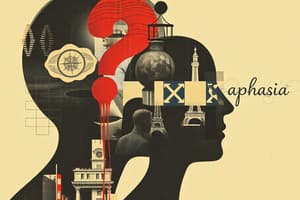Podcast
Questions and Answers
Which of the following best describes aphasia?
Which of the following best describes aphasia?
- Difficulty speaking clearly due to muscle weakness.
- Inability to understand another language.
- Inability to use speech muscles.
- Inability to speak, understand, read, or write due to brain injury. (correct)
An individual's inability to understand another language should be confused with a speech or language disorder.
An individual's inability to understand another language should be confused with a speech or language disorder.
False (B)
Which of the following conditions is a potential cause of speech and language disorders?
Which of the following conditions is a potential cause of speech and language disorders?
- Genetic problems.
- Brain injury.
- Stroke.
- All of the above. (correct)
A partial or total loss of speech and language skills caused by brain injury is known as ______.
A partial or total loss of speech and language skills caused by brain injury is known as ______.
Match the type of aphasia with its description:
Match the type of aphasia with its description:
Which type of aphasia is characterized by a combination of both receptive and expressive language difficulties?
Which type of aphasia is characterized by a combination of both receptive and expressive language difficulties?
Clients with expressive aphasia are typically unaware of the mistakes they make in speech or writing.
Clients with expressive aphasia are typically unaware of the mistakes they make in speech or writing.
Define apraxia of speech in a short sentence.
Define apraxia of speech in a short sentence.
What is a primary characteristic of apraxia of speech?
What is a primary characteristic of apraxia of speech?
Difficulty speaking clearly due to weakness or paralysis in the muscles used for speech is known as ______.
Difficulty speaking clearly due to weakness or paralysis in the muscles used for speech is known as ______.
Which of the following conditions is NOT listed as a potential cause of dysarthria?
Which of the following conditions is NOT listed as a potential cause of dysarthria?
Speech errors associated with dysarthria are typically inconsistent and unpredictable.
Speech errors associated with dysarthria are typically inconsistent and unpredictable.
How can speech and language disorders affect one's emotional state?
How can speech and language disorders affect one's emotional state?
Which of the following is a likely emotional effect of speech and language disorders?
Which of the following is a likely emotional effect of speech and language disorders?
The primary goal of treatment for speech and language disorders is to improve a person's ability to ______.
The primary goal of treatment for speech and language disorders is to improve a person's ability to ______.
The effectiveness of speech and language therapy is solely dependent on the client's age.
The effectiveness of speech and language therapy is solely dependent on the client's age.
Match the communication tool with its description:
Match the communication tool with its description:
What is the purpose of communication boards?
What is the purpose of communication boards?
List three ways a PSW can support clients with speech and language disorders?
List three ways a PSW can support clients with speech and language disorders?
Why should a PSW be mindful of their facial expressions when caring for clients with speech and language disorders?
Why should a PSW be mindful of their facial expressions when caring for clients with speech and language disorders?
According to the content, senses of sight and ______ are important for communicating, learning, moving about, and performing ADL's.
According to the content, senses of sight and ______ are important for communicating, learning, moving about, and performing ADL's.
Hearing and vision disorders only affect older adults.
Hearing and vision disorders only affect older adults.
Match the cause with the vision or hearing disorder category:
Match the cause with the vision or hearing disorder category:
Which of the following is NOT listed as a typical cause of hearing loss?
Which of the following is NOT listed as a typical cause of hearing loss?
What are three easily seen signs that a person might be experiencing hearing difficulties?
What are three easily seen signs that a person might be experiencing hearing difficulties?
Eye disorders and vision impairment only occur in older adults.
Eye disorders and vision impairment only occur in older adults.
Which of the following is an effect of eye disorders and vision impairment on an individual?
Which of the following is an effect of eye disorders and vision impairment on an individual?
When assisting someone who is blind, it is recommended to walk slightly ______, allowing them to rest their arm on yours.
When assisting someone who is blind, it is recommended to walk slightly ______, allowing them to rest their arm on yours.
When caring for a client with vision impairment, why is it important to keep the furniture arrangement consistent?
When caring for a client with vision impairment, why is it important to keep the furniture arrangement consistent?
List three safety measures that should be taken into consideration when caring for individuals with vision impairment.
List three safety measures that should be taken into consideration when caring for individuals with vision impairment.
Flashcards
Speech and Language Disorders
Speech and Language Disorders
Inability to speak, understand, read, or write, which can occur at any age.
Aphasia
Aphasia
Partial or total loss of speech and language skills caused by brain injury.
Receptive Aphasia
Receptive Aphasia
Type of aphasia characterized by difficulty understanding written and spoken words, but speech may be fluent.
Expressive Aphasia
Expressive Aphasia
Signup and view all the flashcards
Global Aphasia
Global Aphasia
Signup and view all the flashcards
Apraxia of Speech
Apraxia of Speech
Signup and view all the flashcards
Dysarthria
Dysarthria
Signup and view all the flashcards
Communication Tools
Communication Tools
Signup and view all the flashcards
Communication Boards
Communication Boards
Signup and view all the flashcards
Sight and Hearing
Sight and Hearing
Signup and view all the flashcards
Hearing Impairment
Hearing Impairment
Signup and view all the flashcards
Signs of Hearing Loss
Signs of Hearing Loss
Signup and view all the flashcards
Vision Impairment
Vision Impairment
Signup and view all the flashcards
Safety for Vision Impairment
Safety for Vision Impairment
Signup and view all the flashcards
Study Notes
Speech and Language Disorders
- Affects ability to speak, understand, read, or write.
- It is not the same as being unable to understand another language.
- Can occur at any age.
Possible Causes of Speech and Language Disorders
- Genetic problems.
- Brain injury.
- Accident.
- Infection.
- Drug use.
- Stroke.
- Disease.
- Hearing loss.
- Brain tumor.
- Problems with body structures used for speech.
Aphasia
- This is the partial or total loss of speech and language skills caused by brain injury.
- Can be caused by a cerebral vascular accident (CVA), commonly called a stroke.
- May result from head injuries, brain infections or cancer (tumor in the brain).
- There are three types of Aphasia:
- Receptive (Fluent)
- Expressive (Non-Fluent)
- Global (both receptive and expressive).
Receptive Aphasia
- The person has difficulty understanding written and spoken words.
- The person cannot understand their own words.
- The person has difficulty understanding what is said or read.
- Speech may be mixed up or “muddled”.
- The person may make up or use the wrong words unaware of the mistakes.
Expressive Aphasia
- The person has difficulty speaking and writing.
- The person understands spoken and written words.
- Speech may be jumbled or slurred and difficult to understand.
- The person may "think one thing but say another".
- The person cannot think of the right word or put the right sounds together to form words or sentences.
- The person may leave out connecting words.
- People are very aware of their mistakes, which can be frustrating.
Global Aphasia
- Global Aphasia is a combination of both types.
- It is the most severe type of aphasia.
- The person has difficulty speaking and understanding written and spoken language and can’t read or write
- The person may only say “yes”, “no”, and make sounds such as "da da.”
- They may have lost all speech and language skills.
Apraxia
- A person cannot use their speech muscles to produce understandable speech (tongue, lips, jaw).
- Understands speech and knows what to say.
- Their brain cannot coordinate the speech muscles to make the movements.
- It is caused by damage to the motor speech area in the brain.
- The person is difficult to understand and speech is usually slow.
- Inconsistent speech is common.
- The person finds it is difficult to put words in the right order, or find words.
Dysarthria
- The person has difficulty speaking clearly.
- It is caused by weakness or paralysis in the muscles used for speech.
- Common causes include cerebral palsy, multiple sclerosis, head injury, tumor, infection, or CVA (stroke).
- The person may have slurred speech and speak in flat, harsh or nasal tones.
- The person has problems forming words or spacing their words.
- Speech errors are usually consistent and predictable.
Emotional Effects of Speech and Language Disorders
- Verbal communication is important for functioning and maintaining relationships with others.
- Difficulty in communicating may lead to:
- Avoiding social situations.
- Avoiding friends, family.
- Extreme stress in relationships with family.
- Loss of employment.
- Difficulty doing routine tasks, like shopping or paying bills.
- Frustration, depression, or anger.
- Low self-esteem, shame, or guilt.
Treatment of Speech and Language Disorders
- The goal of treatment aims to improve the person's ability to communicate.
- Depends on many factors:
- The cause, amount, and area of brain damage
- Client's age and health
- Client's willingness and ability to learn
- A speech-language pathologist and other healthcare team members help the person to:
- Improve affected language skills.
- Use remaining abilities.
- Restore language abilities to the extent possible.
- Learn other methods of communication.
- Strengthen the muscles of speech.
Communication Tools
- Communication boards hold pictures or words that show functions or tasks.
- Related to ADL’s such as sleep, food, drink, medicine, and eyeglasses.
- Selection depends on the client’s needs
- Mechanical and electronic devices offer a range of complexity and cost
- May or may not be portable.
- Client touches a picture, and the message is then voiced or printed on a screen
- Computers or tablets feature screen readers and magnification systems
- They may be customizable and have a voice synthesizer .
- They can be expensive.
Supporting and Communicating With Clients
- Follow the care plan – use DIPPS.
- Use communication methods that are best for the client.
- Be mindful of your facial expression and do not reflect impatience or frustration.
- Consider the communication techniques and adapt them to help communicate with the client.
- Be aware of your feelings and frustrations.
- Check for signs of client fatigue, like drooping shoulders, irritability, lack of interest, or decline in understanding.
- Always include the client in the conversation.
Hearing and Vision Disorders
- Senses of sight and hearing are important for communicating, learning, moving about, and performing ADL’s.
- Keep people safe by alerting them to danger.
- It is believed that People who are dying can hear up until their death.
- Challenges are common among all age groups,
- Common causes include:
- Genetic
- Birth complications
- Diseases
- Accidents
- Aging
Ear Disorders and Hearing Impairment
- Ears are used for hearing and balance.
- Ranges from slight to complete deafness.
- Onset is usually gradual.
- Can affect one ear or both.
- The most common causes include;
- Aging
- Prolonged exposure to loud noise
- Other causes;
- Accident
- Illness
- Exposure to certain drugs or chemicals
- Genetics
- Obvious signs
- Speaking too loudly
- Leaning forward to hear
- Turning and cupping the unaffected ear toward the speaker
- Responding inappropriately
- Asking for words to be repeated
- May cause speech challenges
- Affects all aspects of a person's life.
Eye Disorders and Vision Impairment
- Can occur at all ages, varying in severity.
- Onset may be sudden or gradual.
- Causes;
- Health conditions
- Accidents
- Eye diseases
- Congenital (genetics)
- Effects;
- Physical, emotional, social, intellectual, and spiritual health
- Loss of independence and self-esteem
- Decrease ability to complete ADL’s
- Social isolation
- Increased Risk for injury
- Outdoor sidewalks etc. must be kept clear
- Rooms and hallways should be free of clutter
- When walking with someone who is blind, walk slightly ahead, their arm resting on yours
- Keep doors fully open or fully closed, never partially open
- Arrange furniture to suit client needs and keep it the same.
- Orient client to new setting
- Ensure the call bell is within client reach
Studying That Suits You
Use AI to generate personalized quizzes and flashcards to suit your learning preferences.




